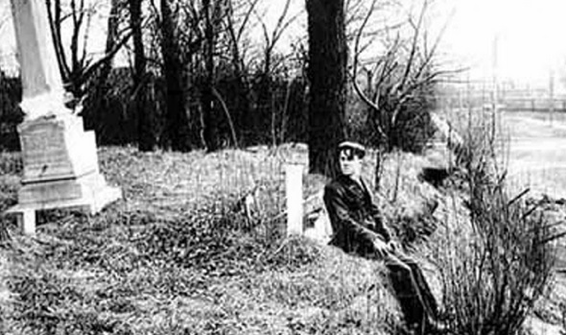They say the only constant is change. And if this adage is true, then city parks are no exception. Over the years, parkland is graded and re-graded, new buildings go up and the old ones come down, and park amenities once considered cutting-edge eventually grow obsolete and are removed or abandoned. Despite the momentum of progress, a few remnants of the past still exist in Minneapolis parks. These “leftovers” allow us to literally see and touch park features that were wiped off the map long ago. And as they give us new perspectives, our appreciation for Minneapolis’ parks grows richer.
Loring Cascade, Theodore Wirth Park
Charles Loring, the president of the first Park Board, is considered the “Father of Minneapolis Parks.” Even a cursory review of his life shows a long list of accomplishments both great and small. One of his lesser-known achievements was an artificial waterfall built in 1917 in Glenwood Park (renamed Theodore Wirth Park in 1938). Designed by Francois Scotti, the Loring Cascade appeared to be – in Wirth’s words – “nature’s own creation.” Water was pumped from Wirth Lake over a 40-foot artificial rock formation. But as feared from the beginning, the cascade could not withstand the rigors of Minnesota’s climate. The Park Board shut off the pump and abandoned the waterfall in the 1940s. But the ruins of the Loring Cascade endure – crumbling and overgrown but unmistakable – adjacent to the bike trail on Theodore Wirth Parkway just north of Glenwood Avenue.
Bridge Remnants, First Bridge Park
In 1855, the first permanent bridge to span the Mississippi River anywhere along its course was constructed near downtown Minneapolis. That first Hennepin Avenue Bridge is long gone, as are the bridges that replaced it – one built in 1876 and the next in 1891. The third bridge lasted nearly 100 years, and during the construction of the fourth (and current) Hennepin Avenue Bridge, workers uncovered remnants of the earlier bridges. Today, on the banks of the Mississippi near the Federal Reserve Bank, you can view the stone foundations of the earlier bridges as well as two rusting hulks – components from the bridges’ suspension cable systems.
Gravestones, Beltrami Park
Before public parks became common, it was not unusual for people to stroll about and picnic in “garden cemeteries.” One such place was the Maple Hill Cemetery in northeast Minneapolis. The final resting place of many Civil War soldiers, the cemetery was closed in 1890. Soon after, newspapers began to report on the breaking and stealing of grave markers by nighttime vandals. The Park Board was able to take control of the site in 1908, relocate many of the human remains to Fort Snelling and other cemeteries, and transform Maple Hill Cemetery into Beltrami Park. Strange as it seems, a few of the original grave markers were left behind as a remembrance of the land’s original use. Stranger still, because so many gravestones had been moved or destroyed years earlier, no one knows how many early settlers and soldiers are still interred in the park.
Carriage Road Remnant, Washburn Fair Oaks Park
After your next visit to the Minneapolis Institute of Art, take a walk through nearby Washburn Fair Oaks Park. Along the park’s northern edge, you might spot a swath of old pavement in the grass. It’s hard to believe, but this nondescript chunk of rocky asphalt is all that’s left of what was once the grandest mansion in Minneapolis. Built in 1887, Fair Oaks was the estate of US Representative and Senator William Washburn and his wife, Lizzie. The Washburns deeded their beloved home and the surrounding land to the Park Board in 1911. Several women’s organizations were housed there during and after World War I, but the Park Board had no use for such a large house. Fair Oaks fell into disrepair and was demolished in 1924. Now this extravagant mansion and its luscious grounds can be appreciated only through photos and writings – except for this small section of the estate’s original carriage road.
Mill Dam Remnant, Minnehaha Park
While Saint Anthony Falls provided the power that put Minneapolis on the map, the area’s first known flourmill was near a different waterfall. A millwright by the name of Ard Godfrey moved from Maine to Minnesota, settled in the countryside southeast of Minneapolis, dammed Minnehaha Creek downstream from its falls, and built a flour mill there in 1857. The mill was operated by Godfrey until 1871 and by several others until around 1887, when it was destroyed by fire. The mill’s ruins, including the large wooden mill wheel, succumbed to the elements decades ago, but a remnant of the limestone dam that once spanned the creek still survives. It’s clearly visible on the north side of the creek, downstream from where the Veterans Home Bridge crosses over the glen.
—
For more insights into the history of Minneapolis parks:
- Visit the Minneapolis Park & Recreation Board web site: https://www.minneapolisparks.org/parks__destinations/parks__lakes/. Each park has its own web page that includes a history tab.
- Browse the postings on the Minneapolis Park History blog: https://minneapolisparkhistory.com/.
- Read City of Parks: The Story of Minneapolis Parks by David C. Smith. Purchases of this book from the University of Minnesota Press (https://www.upress.umn.edu/) benefit the Minneapolis Parks Foundation.
To see more intriguing images and discover wide-ranging history, we recommend:

